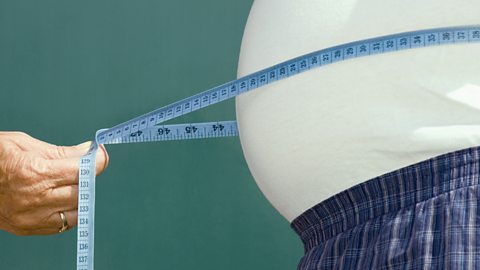What is digestion?
Digestion is the breaking down of the food we eat into other substances that our bodies can absorb and use.There are mechanical and chemical digestive processes.Mechanical digestion includes:
- chewing in the mouth with the teeth.
- churning in the stomach.
Without digestion, we could not absorb food into our bodies and use it.Digestion happens in the digestive system, which begins at the mouth and ends at the anus.
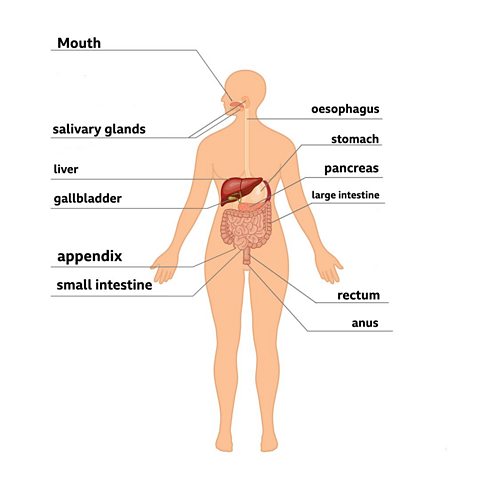
After we swallow, our food passes through these organs in turn:
- oesophagus or gullet
- stomach
- small intestine
- large intestine
Stages of digestion
Different things happen to food as it passes through the digestive system:
- food is digested in the mouth, stomach and small intestine
- digested food is absorbed into the blood stream in the small intestine
- excess water is absorbed back into the body in the large intestine
- any undigested food passes out of the anus as faeces (or poo) when we go to the toilet
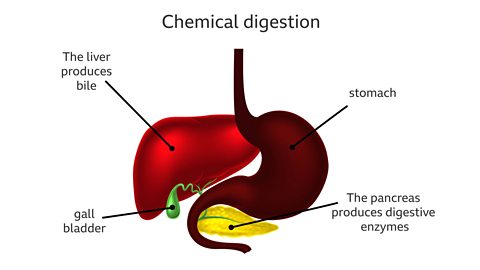
Liver and pancreas
The liver and the pancreas play an important part in digestion. The liver produces bile, which helps the digestion of lipids (fats and oil). The pancreas produces biological catalysts called digestive enzymes which speed up the digestive reactions. This is chemical digestion.

Ingestion
Food enters the digestive system through the mouth. This process is called ingestion. Once in the mouth, the food is chewed to form a ball of food called a bolus. This passes down the oesophagus and into the stomach.
Peristalsis
Food is moved through the digestive system by a process called peristalsis. Two sets of muscles in the gut wall are involved
They work together to produce wave-like contractions. These have a ÔÇÿsqueezing actionÔÇÖ that pushes the bolus through the digestive system.
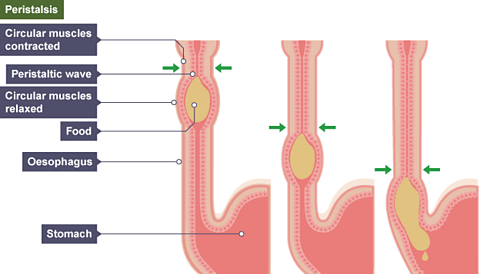
Digestion and enzymes
Our teeth break food down into small pieces when we chew. This is only a start to the process of digestion, as chewed pieces of food are still too large to be absorbed by the body. Food has to be broken down chemically into really small particles before it can be absorbed. This is called chemical digestion.
Enzymes
Enzymes are chemicals which help to speed up the breakdown of large food molecules.
Enzymes are not living things. They are just special proteins that can break large molecules into small molecules. Different types of enzymes can break down different nutrients:
- amylase and other carbohydrase enzymes break down carbohydrates into sugar e.g. starch into glucose.
- protease enzymes break down proteins into amino acids.
- lipase enzymes break down lipids (fats and oils) into fatty acids and glycerol.
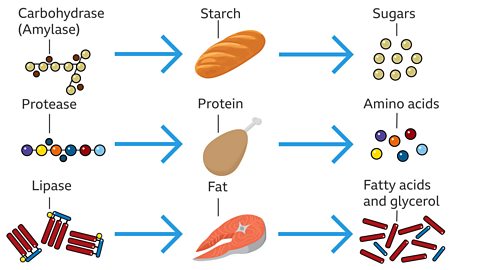
Carbohydrates
Carbohydrates are digested in the mouth, stomach and small intestine. Carbohydrase enzymes (amylase) break down carbohydrates into sugars.
The saliva in your mouth contains amylase, which is another starch digesting enzyme. If you chew a piece of bread for long enough (about 60 seconds), the starch it contains is digested to sugar, and it begins to taste sweet.

How to turn starch into glucose.
Proteins
Proteins are digested in the stomach and small intestine. Protease enzymes break down proteins into amino acids. Digestion of proteins in the stomach is helped by stomach acid, which is strong hydrochloric acid. This also kills harmful microorganisms that may be in the food.

Lipids (fats and oils)
Lipase enzymes break down fat into fatty acids and glycerol. Digestion of fat in the small intestine is helped by bile, made in the liver. Bile breaks the fat into small droplets that are easier for the lipase enzymes to work on. Bile is not an enzyme.
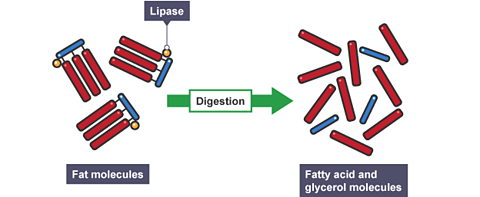
Substances that are not digested
Minerals, vitamins and water are already small enough to be absorbed by the body without being broken down, so they are not digested.Digestive enzymes cannot break down dietary fibre, which is why the body cannot absorb it.
Absorption and egestion
These are four processes that happen in the digestive system:
ingestion (eating)  digestion (breaking down)  absorption  egestion (removal from the body)
Absorption
Digested food molecules are absorbed in the small intestine. This means that they pass through the wall of the small intestine and into our bloodstream. Once there, the digested food molecules are carried around the body to where they are needed.
Only small, soluble substances can pass across the wall of the small intestine. Large insoluble substances cannot pass through. The slideshow shows how this happens:
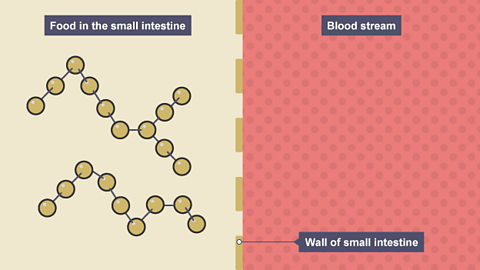
Image caption, Food molecules in the small intestine are too large to pass across its wall and into the bloodstream
Image caption, Carbohydrase enzymes in the small intestine begin to digest the food into smaller molecules
Image caption, The food molecules are now small enough to move by diffusion through the wall of the small intestine into the bloodstream
1 of 3
Adaptations for absorption
Absorption across a surface happens quickly and efficiently if:
- the surface is thin
- the surface area is large
The inner wall of the small intestine has adapted so that substances pass across it quickly and efficiently. It:
- has a thin wall, just one cell thick, so there is a short diffusion distance
- is long (over 6 m), to increase surface area
- has many tiny villi (small, slender, projections), to increase surface area
- has good blood supply, to create a high diffusion gradient
- is permeable, to allow molecules to pass through easily
If the small intestine had a thick wall and a small surface area, a lot of digested food might pass out of the body before it had a chance to be absorbed.
The villi (one of them is called a villus) stick out of the inside surface of the small intestine and give a big surface area. They also contain blood capillaries to carry away the absorbed food molecules.
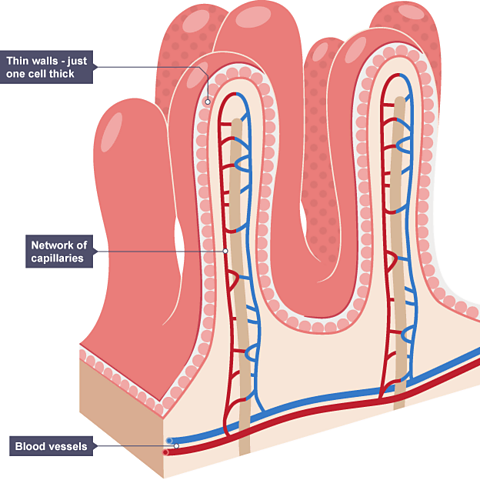
Egestion

Excess water is absorbed back into the body in the large intestine. What is left then is undigested food. This is stored in the rectum, the lower part of the large intestine, until we are ready to go to the toilet. It then comes out of the rectum through the anus as faeces.
The process of passing out the remains of food that has not been digested, as faeces, through the anus is called egestion.
Take care not to confuse egestion (removal of undigested food from the body) with excretion (removal of waste products from chemical reactions from the body).


Bacteria
The digestive system contains many bacteria and about half of the dry weight of faeces consists of bacteria. Bacteria in the digestive system are important. For example, they:
- can digest some substances that humans cannot digest, such as certain carbohydrates
- reduce the chance of harmful bacteria multiplying and causing disease
- produce some vitamins that humans need, such as vitamins B and K

Modelling the digestive system
This is a common experiment used to model the digestive system and should help you understand how to work scientifically.
Aim of the experimentTo use Visking tubing to model the digestive system and show what substances can pass through its lining.
Visking tubing is a material that has very small holes. The holes are so small that large molecules, such as starch, cannot pass through. However, small molecules like water or glucose are small enough to diffuse through.
Method
- Set up two sets of the apparatus as in the diagram.
- Put 1cm3 of amylase enzyme into tube 1 but not tube 2.
- Leave at room temperature for five minutes.
- Test for starch using iodine and glucose using BenedictÔÇÖs reagent inside and outside both tubes.
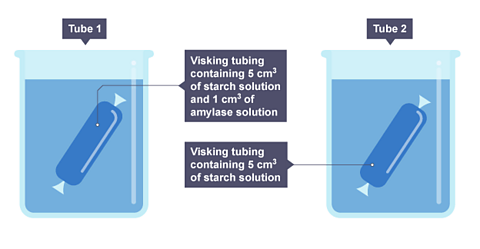
RisksCare must be taken with glassware, iodine solution and BenedictÔÇÖs solution.
Expected results
Tube 1 (with amylase)
| Inside | Outside | |
|---|---|---|
| Starch present | Yes | No |
| Glucose present | Yes | Yes |
Tube 2 (without amylase)
| Inside | Outside | |
|---|---|---|
| Starch present | Yes | No |
| Glucose present | No | No |
What the results mean
- There is no starch outside the Visking tubing. It is too large to pass through it.
- Glucose is present in the solution containing amylase, but not in the solution that doesn't contain amylase. Amylase breaks down starch into glucose.
- There is glucose outside the Visking tubing. Glucose is small enough to pass through it.
Test your knowledge
What is fibre?
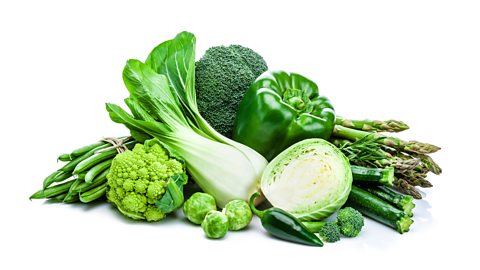
Dietary fibre is made up of plant material, in particular cellulose from plant cell walls that your body cannot break down.
It is essential in helping our body to remain healthy because it helps to move the food we eat through our digestive system, allowing the body to absorb nutrients, whilst moving the waste products easily through our system to be removed.

Soluble and insoluble fibre
Foods that contain a lot of fibre typically contain both soluble and insoluble fibre.
Soluble fibre dissolves easily in water. It is broken down in the large intestine into a gel-like substance. One of its many benefits is to help reduce blood cholesterol.
Insoluble fibre does not dissolve in water. It travels around the digestive tract absorbing fluid and picking up other waste matter. The fibre aids the journey of the waste matter through the intestines and out through the anus. Not surprisingly this type of fibre helps to prevent constipation!
How much dietary fibre do I need?
The recommended daily intake of fibre varies with age:
- 11 to 16 year olds ÔÇô 25g per day
- 16 year olds and above ÔÇô 30g per day
A diet that is high in fibre can help to reduce hunger and help you to feel fuller for longer.
Ways to increase fibre in your diet
Fibre rich foods include oats, pulses, whole grains and vegetables.
There are many things you can do to increase the amount of fibre in your diet:
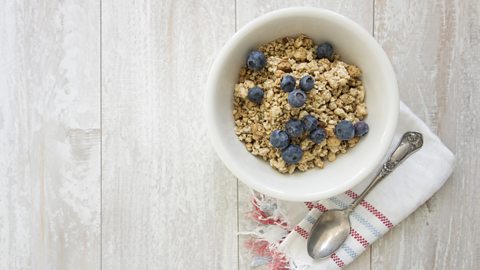
- start the day with a high fibre breakfast cereal ÔÇô e.g., bran flakes
- go for wholemeal breads
- choose wholegrains ÔÇô e.g., wholewheat pasta
- go for potatoes with skins ÔÇô e.g., a baked potato
- for snacks try fruit, vegetable sticks, oatcakes or unsalted nuts
- eat plenty of vegetables with meals
- have some fresh or dried fruit for snacks or a dessert


The correct amount of dietary fibre prevents constipation and reduces the risk of heart disease, stroke, type-2 diabetes, bowel cancer and obesity.
Test your knowledge
Summary
The processes that happen in the digestive system:
ingestion (eating food)  digestion (breaking food down)  absorption  egestion (removal of undigested food from the body)
| Region of digestive system | Process |
|---|---|
| Mouth | Food is physically digested by teeth ÔÇô broken up into smaller parts to increase surface area. Food is chemically digested by the enzyme, amylase |
| Oesophagus | Food is moved through the digestive system by the process called peristalsis |
| Stomach | The stomach produces hydrochloric acid. Enzymes in the stomach work best in acidic conditions |
| Small intestine | Enzymes finish the process of digestion. Digested food molecules are absorbed into the bloodstream |
| Large intestine | Excess water is absorbed back into the body. Undigested food is stored in the rectum, the lower part of the large intestine. Egestion then occurs |
More on Biology
Find out more by working through a topic
- count4 of 11

- count5 of 11
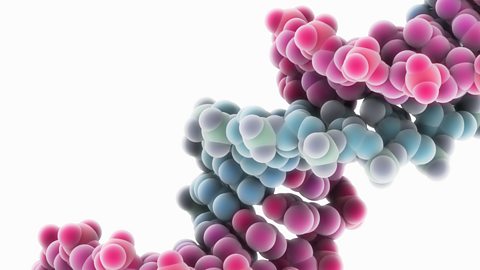
- count6 of 11

- count7 of 11
